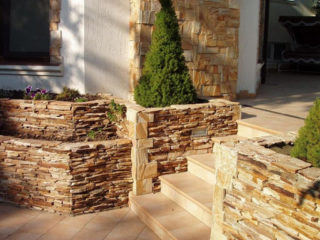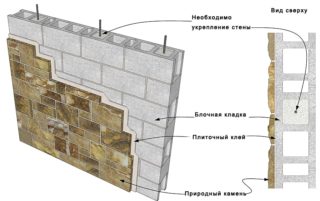The plinth is a very important part of the foundation, which is located above the ground. He needs additional protection from the effects of precipitation, adverse weather conditions. If water gets inside the material and freezes, its destruction will begin. Facing the base with natural stone is one of the best protection methods, which has a decorative function.
Varieties of natural stones for facing the basement
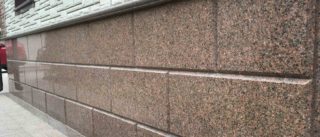
Natural material looks beautiful and is durable. However, it is difficult to fix it. For work, they use shell rock, granite, slate, sandstone and quarrystone. Each has certain properties that you need to consider when choosing.
Granite
Granite is often used for cladding a house. It has a beautiful appearance due to different shades, as well as blotches of other breeds. Granite is considered one of the most durable materials. It is able to protect the base from mechanical damage, acid atmospheric precipitation, salt solution, the development of mold and mildew.
The advantage of the material is its textural variety. The appearance of the base will turn out to be unique and unrepeatable. Even under the influence of direct sunlight, granite does not lose its color. However, the stone is quite heavy. It is better to choose the texture in advance. The cladding process requires certain skills from the master.
Sandstone
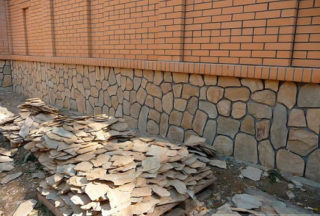
Sandstone is a rock that has a layered structure. It contains mica, quartz, feldspars. Often, yellow and red impurities are observed in the formation. It has a good decorative effect, therefore it is considered a popular building material. Sandstone is a moisture resistant rock that can withstand up to 50 freeze cycles.
Natural stone is resistant to abrasion and has a wide color palette. The material withstands mechanical pressure well. It is inferior in strength to granite and marble, but superior to limestone and other soft minerals. Has an affordable cost.
Shell rock
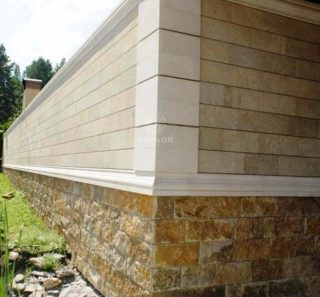
The popular is the plinth made of shell rock. This material is dense, but at the same time lightweight. The shape of the stone makes it easy to install. Due to its structure, the product provides good noise insulation properties, is a natural insulation. Shell rock is an environmentally friendly material that is resistant to negative temperatures (up to 70 freezing cycles).
The shade of the product depends on its composition. It happens light yellow, milky, white and yellow. Simplicity of processing is also considered to be its advantage. However, for use on the outer surface of a building, additional impregnation of the material with a water-repellent compound is required.
Slate
You can cover the base with a butt. This is a rock with which you can achieve an original decorative effect. Such a stone has a different shape, but it is better to finish it with elements with smooth edges. Sizes range from 20-50 cm.
Features of the material and its choice
Finishing a foundation with a stone is not an easy procedure. When choosing a material, you need to take into account the following nuances:
- Shell rock, like sandstone, are the cheapest products, but they cannot boast of an abundance of shades.
- Granite is stronger and more durable, but expensive and time consuming to finish.
- If the material has a large number of indentations, it will have to be discarded. It will be difficult to care for such a cladding and it will not be possible to completely clean it of contamination.
- Finishing the plinth with natural stone requires material quality certificates. This is especially true for products that pose a radiation hazard.
If you choose the right cladding, the plinth will look beautiful and complete.
Laying methods
If liquid concrete was used for the construction of the foundation, shell rock or quartzite is used for the work. Large elements are laid after the formwork is installed. No more than 0.5 m of stone is laid per day.
Advantages and disadvantages of natural stones for the basement
You can also use artificial material to finish the foundation, but natural elements have certain advantages:
- resistance to mechanical damage;
- resistance to deformation processes due to exposure to temperature changes;
- long period of operation;
- good decorative qualities;
- a variety of shades, sizes and shapes of elements;
- ease of maintenance (the material practically does not absorb dirt, so it does not have to be cleaned often);
- the ability to replace individual elements.
Structures of different shapes can be faced with natural stone.
Some types of stone are characterized by a large mass, which increases the load on the foundation. The work requires additional reinforcement of the structure, as well as the use of stops. Natural stone plinth trim is expensive.
Surface preparation
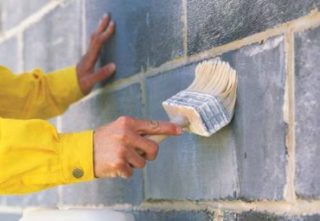
Before starting the cladding, the facade is prepared. The base is cleaned of dust, dirt, sagging. This is followed by priming the surface. If the box is recently erected, you need to give it time to shrink. After priming, a reinforcing mesh is fixed on the surface. Fix the stone to the concrete foundation and to the frame. To fix the elements on the insulation, mushroom dowels are used.
When using heavy fragments, a metal frame is pre-equipped. All irregularities on the base must be eliminated, the surface is completely dry.
Plinth facing technology with natural stone
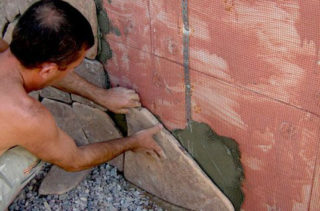
In order for the finish to last a long time and look beautiful, you need to follow the technology of its attachment. Installation requires a building level, a grinder, a plaster mixture, a plumb line, a material for waterproofing and insulation, a reinforcing mesh, a primer solution. For the final protection of the stone surface, varnish is required. The work involves the following stages:
- Surface preparation.
- Substrate priming with concrete contact. It is necessary to choose a mixture of a coarse fraction in order to increase the adhesion of the stone to the base.
- Material preparation. The items need to be sorted. One end side of them should be flat.
- Installation. The glue is applied to the moistened stone surface. After that, he is leaned against the wall. For a high fit, the product must be tapped with a mallet. The rest of the fragments are applied as close to each other as possible.
- If large gaps form between the stones during work, they are filled with small pieces.
The seams are filled with glue during the laying of the material. Remains of the retainer on the front side of the trim are removed immediately. After the glue has set, a protective varnish is applied to the natural stone.
Natural materials for finishing the facade emphasize the individuality of the building and increase its decorative effect. Natural stone requires periodic cleaning from dirt and dust, which is not difficult. With proper operation, such a cladding will last for many years without changing its original appearance.

